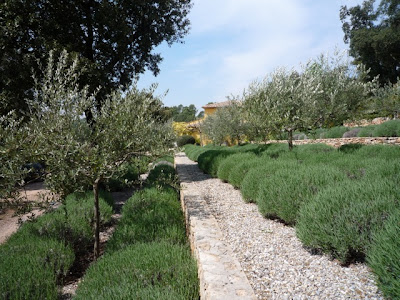When walking in the countryside at this time of the year, the plants that stand out most are the Euphorbia's. The three photos above are the most common Euphorbias in the area. From top to bottom: Euphorbia characias, Euphorbia cyparissias and Euphorbia serrata.
Going down to the coast there are two distinct Euphorbias, Euphorbia dendroides (Tree spurge) a rounded shrub up to 2m tall:
and Euphorbia paralias:
The name Euphorbia is named after "Euphorbus", a Greek physician to King Juba II of Numidia (50-52 BB-23AD). He wrote about a cactus like plant that was a powerful laxative. King Juba (married to the daughter of Anthony and Cleopatra) subsequently named this plant after his physician. When "Carl Linnaeus" created his system of plant classification, he assigned the name Euphorbia to the entire genus in the physician's honour.
The Euphorbias are unique in the plant kingdom. What we think is a flower is called a Cyathium. The Cyathium includes the male and female flowers with their specific parts, the nectar glands and the Bracts (Bracteole if they are small).

The Bracts, depending on the species can be very colourful as in Euphorbia pulcherrima (Ponsettia):
and in Euphorbia griffithii:

Euphorbia is one of the most diverse genera in the plant kingdom. They belong to the Euphorbiaceae family which includes 2008 species. The Genus Euphorbia is found in tropical and subtropical regions of Africa and the Americas, but also in the temperate zones worldwide. The plants vary, in most cases the female and male parts are on the same plant, but this is not always the case as for example in Euphorbia obesa.
The "succulent species" come mostly from Africa, America and Madagscar. Euphorbia obesa originates in South Africa, the female flowers are on the left plant, the male flowers on the right one:
Euphorbia myrsinitis originating from S. and E. Europe to Turkey and C. Asia, does very well in our gardens. It is a succulent very suitable to a rockery:
Some resemble more a Cactus as in Euphorbia resinifera, it is only when the this Euphorbia is in flower that we can recognise it as a Euphorbia. Euphorbia resinifera was used in poultices and creams to create a longlasting prickling sensation to the skin. Nowadays considered too dangerous to use.
Another Euphorbia type cactus seen often inside the home, is Euphorbia milii from Madagascar:



Euphorbia myrsinitis originating from S. and E. Europe to Turkey and C. Asia, does very well in our gardens. It is a succulent very suitable to a rockery:
Some resemble more a Cactus as in Euphorbia resinifera, it is only when the this Euphorbia is in flower that we can recognise it as a Euphorbia. Euphorbia resinifera was used in poultices and creams to create a longlasting prickling sensation to the skin. Nowadays considered too dangerous to use.

Euphorbia "Diamond Frost" is a relatively new cultivar. A wonderful annual that gives you pleasure from May to the frost.

The common name for Euphorbia is "Spurge". This name derives from the Middle English/Old French word "Espurge" (to purge) due to the use of the plant's sap as a purgative. Most spurges contain carcinogenic, highly irritant, diterpene esters and are strong purgatives. All Euphorbias are toxic if eaten. The sap (latex) is a serious skin and eye iritant.
The only Euphorbia still used in herbal medicine is Euphorbia hirta, it is ester free and regarded worldwide as a safe, effective herb. Internally it is used for asthma, bronchitis, emphysema, nervous cough, catarrh, hay fever, and amoebic dysentry. Externally for burns and warts.

Bibliography: RHS: Encyclopedia of Herbs; Wikipedia: Euphorbia; Fytotherapeutisch compendium: J. van Hellemont; RHS: A-Z Encyclopedia of Garden Plants; The Pharmaceutical Press: Herbal Medicines.
















